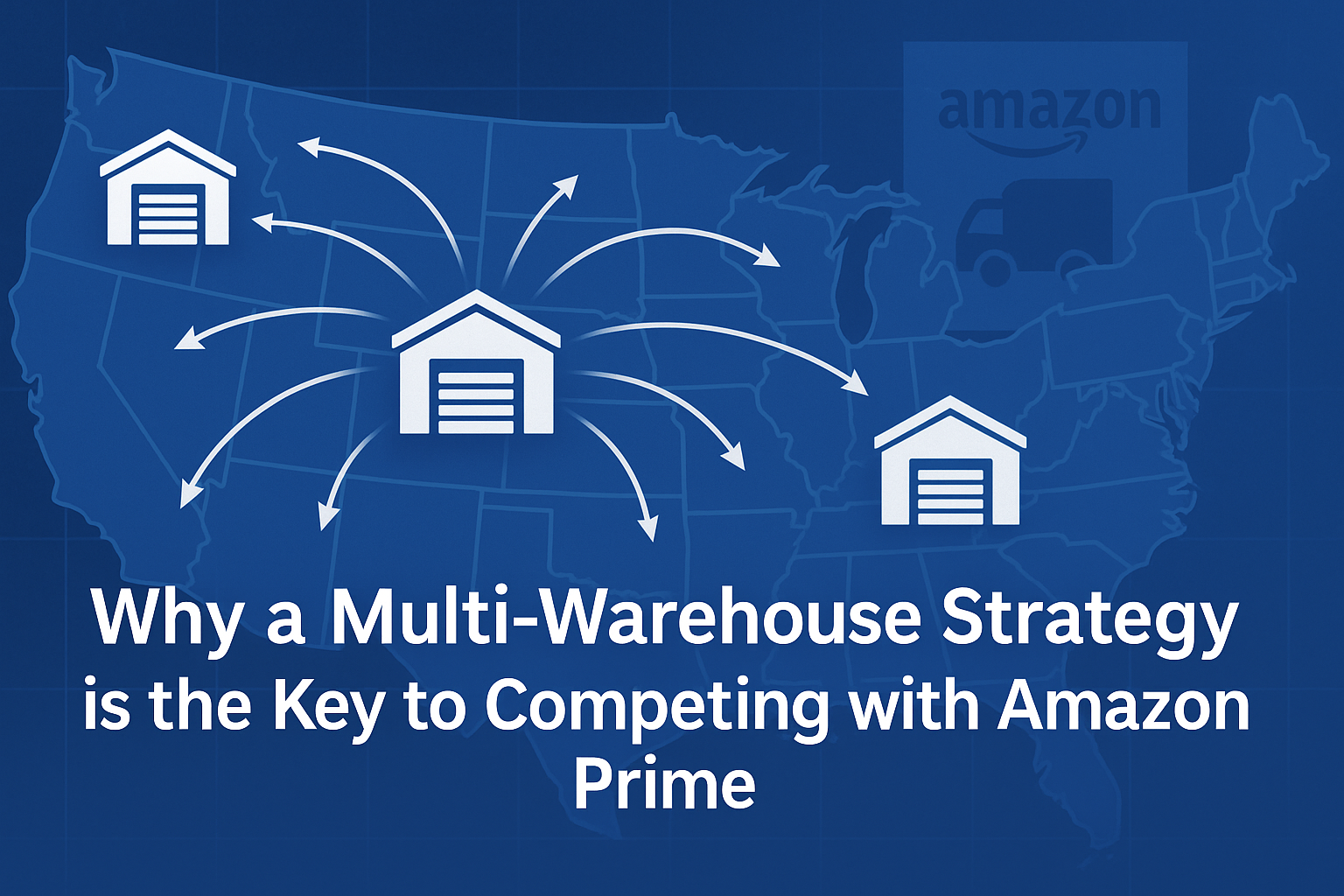In today’s hyper-competitive e-commerce landscape, customer expectations have never been higher. Thanks in no small part to the “Amazon Prime effect,” consumers now expect lightning-fast shipping, often within 1-2 days, and at little to no cost. For many growing global brands, matching this speed and efficiency can feel like an impossible challenge, especially when relying on a single warehouse operation. However, the secret weapon for many successful e-commerce businesses isn’t a magic trick; it’s a meticulously planned multi-warehouse strategy.
This comprehensive guide will delve into why diversifying your storage and fulfillment locations is not just a strategic advantage, but a necessity for thriving in the modern retail environment. We’ll explore how a distributed network of warehouses can dramatically reduce shipping times and costs, enhance customer satisfaction, and ultimately, help your brand compete effectively with the titans of the industry.
—
Beyond a Single Hub: The Limitations of Centralized Warehousing
While a single, central warehouse might seem simpler to manage initially, its limitations quickly become apparent as your business scales. Consider these inherent drawbacks:
- Extended Shipping Times: The further your single warehouse is from your customer, the longer the transit time. This directly impacts customer satisfaction and can lead to cart abandonment.
- Higher Shipping Costs: Longer distances often translate to higher shipping zone costs, eroding your profit margins, especially for businesses offering “free” or low-cost shipping.
- Increased Risk: A single point of failure – whether due to natural disaster, operational disruption, or labor issues – can bring your entire fulfillment operation to a halt.
- Limited Reach: Certain regions might be underserved or entirely out of reach for rapid delivery from a single location, hindering market penetration.
- Inflexibility During Peak Seasons: During holiday rushes or promotional periods, a single warehouse can quickly become overwhelmed, leading to delays and errors.
For brands aspiring to offer a Prime-like experience, these limitations are significant roadblocks. This is where the strategic power of multiple warehouses truly shines.
—
The Multi-Warehouse Advantage: Competing on Speed, Cost, and Customer Experience
Embracing a multi-warehouse strategy offers a cascade of benefits that directly address the challenges posed by the “Amazon Prime effect.” Let’s break down the key advantages:
Faster Shipping Times: Meeting the Need for Speed
The closer your products are to your customers, the faster they can receive their orders. By strategically placing inventory in various geographical locations, you can significantly reduce transit times. Imagine a customer in California ordering from your brand. If your only warehouse is in New York, that’s a cross-country journey. But with a California fulfillment center, their order can be delivered in 1-2 days, mirroring the speed they’ve come to expect.
Reduced Shipping Costs: Boosting Your Bottom Line
Shipping costs are typically calculated based on distance and shipping zones. A multi-warehouse strategy allows you to ship from the nearest possible location, dramatically lowering these costs. This not only improves your profit margins but also enables you to offer more competitive shipping rates, including free shipping, without breaking the bank. For example, fulfilling an order for a customer in Texas from a Texas fulfillment center will invariably be cheaper than shipping it from the East Coast.
Enhanced Customer Satisfaction: Building Loyalty and Trust
Fast, reliable shipping is a cornerstone of positive customer experience. When customers receive their orders quickly and without issues, they are more likely to become repeat buyers and recommend your brand. In an age where reviews and word-of-mouth are paramount, this translates directly to brand loyalty and increased lifetime value. The ability to offer a “local” delivery experience, even for a global brand, makes a significant difference.
Improved Inventory Management & Risk Mitigation
Distributing your inventory across multiple warehouses provides a built-in safety net. If one location experiences a disruption (e.g., a power outage, natural disaster, or unexpected labor shortage), orders can be rerouted and fulfilled from another location, ensuring business continuity. This redundancy is crucial for maintaining operational resilience and protecting your revenue streams. Furthermore, it allows for more granular inventory management, optimizing stock levels based on regional demand.
Scalability and Flexibility: Adapting to Growth
As your business grows and expands into new markets, a multi-warehouse strategy allows you to scale your operations seamlessly. You can add new warehouse locations as needed to serve emerging customer bases, without overstretching a single facility. This flexibility is vital for long-term sustainable growth and for adapting to fluctuating market demands, such as seasonal spikes in orders.
—
Comparative Analysis: Single vs. Multi-Warehouse Fulfillment
Let’s conduct a comparative analysis to highlight the stark differences between these two approaches:
| Feature | Single Warehouse | Multi-Warehouse Strategy |
|---|---|---|
| Shipping Speed | Slower, especially for distant customers. | Significantly faster, often 1-2 day delivery. |
| Shipping Costs | Higher due to longer distances and zone charges. | Lower due to optimized shipping routes and closer proximity. |
| Customer Satisfaction | Potentially lower due to longer waits. | Higher due to rapid, reliable delivery. |
| Risk Mitigation | High risk of single point of failure. | Low risk due to distributed operations and redundancy. |
| Scalability | Limited, can become bottlenecked. | Highly scalable, allows for expansion into new markets. |
| Inventory Optimization | Less precise, higher likelihood of stockouts in specific regions. | More precise, optimized for regional demand. |
—
Case Study Approach: Real-World Scenarios
Let’s illustrate the power of a multi-warehouse strategy with a few hypothetical, yet common, scenarios:
Scenario 1: The Fast-Growing Apparel Brand
Brand X, an online apparel brand based in Los Angeles, initially ships all orders from a single warehouse in Southern California. As their popularity grows nationwide, they notice increasing shipping costs and longer delivery times for customers on the East Coast and in the Midwest. They also receive customer service inquiries about delivery speed, especially from those accustomed to Amazon Prime’s quick turnaround.
Solution: Brand X partners with a 3PL (third-party logistics) provider like WarehouseTX to establish additional fulfillment centers in New Jersey and Texas. By strategically distributing their most popular items across these three locations, they can now offer 1-2 day shipping to over 80% of their customer base across the contiguous U.S. Shipping costs decrease by an average of 15-20% per order, and customer satisfaction scores for delivery speed soar. This allows them to invest more in marketing and product development, fueling further growth.
Scenario 2: The Seasonal Gifts & Decor Retailer
Brand Y sells unique seasonal gifts and home decor. Their peak season is Q4, leading up to the holidays. In previous years, their single warehouse in the Midwest struggled to keep up with the surge in orders, resulting in delayed shipments, stressed staff, and a backlog of returns after the holidays.
Solution: Brand Y implements a multi-warehouse strategy, adding temporary or flexible space in key regions like Virginia and Iowa for their peak season. This allows them to pre-position inventory closer to high-demand areas, reducing the strain on their primary warehouse. They experience fewer shipping delays, improved order accuracy, and a smoother returns process post-holiday. The distributed inventory also acts as a buffer against potential weather disruptions in any single region, ensuring holiday cheer for their customers.
—
Key Considerations for Implementing a Multi-Warehouse Strategy
While the benefits are clear, successfully implementing a multi-warehouse strategy requires careful planning:
- Geographic Footprint: Where are your customers concentrated? Analyze your sales data to identify key regions where additional warehouse presence would make the biggest impact on delivery times and costs.
- Inventory Allocation: How will you distribute your inventory across multiple locations? This requires sophisticated forecasting and inventory management systems to ensure the right products are in the right places at the right time.
- Technology Integration: Your e-commerce platform needs to seamlessly integrate with your 3PL’s warehouse management system (WMS) to provide real-time inventory visibility and efficient order routing.
- Cost-Benefit Analysis: While shipping costs often decrease, there are initial costs associated with setting up new warehouse locations or partnering with a 3PL. A thorough analysis is essential.
- 3PL Partnership: For most growing brands, partnering with an experienced 3PL provider is the most efficient and cost-effective way to implement a multi-warehouse strategy. They offer the infrastructure, technology, and expertise needed to manage complex logistics networks.
—
Unlocking Your E-commerce Potential with a Robust Fulfillment Network
In the race to meet rising customer expectations and compete with market leaders, a multi-warehouse strategy is no longer a luxury; it’s a strategic imperative. By reducing shipping times, lowering costs, and enhancing the overall customer experience, you can build a more resilient, scalable, and ultimately, more profitable e-commerce business. Don’t let the “Amazon Prime effect” intimidate you; leverage a distributed fulfillment network to turn it into your competitive advantage.
At WarehouseTX, we specialize in comprehensive logistics solutions designed to help your brand thrive. Our strategically located fulfillment centers across the U.S., including Texas, California, New Jersey, Iowa, and Virginia, are equipped to handle your warehousing, fulfillment, and return management needs. Ready to feel the power of WTX in E-commerce?
—
Frequently Asked Questions (FAQ)
Q: What is a multi-warehouse strategy?
A multi-warehouse strategy involves storing and fulfilling your products from multiple geographically dispersed warehouse locations. This approach aims to reduce shipping times and costs by placing inventory closer to your customer base, offering a more efficient and responsive supply chain.
Q: How does a multi-warehouse strategy help compete with Amazon Prime?
Amazon Prime sets the standard for fast, often 1-2 day, shipping. A multi-warehouse strategy allows your brand to achieve similar delivery speeds by shipping from the nearest facility to the customer, minimizing transit times and directly competing on the speed and convenience that consumers now expect.
Q: Will a multi-warehouse strategy increase my costs?
While there might be initial setup costs or 3PL partnership fees, a multi-warehouse strategy often leads to significant long-term cost savings. These savings come primarily from reduced shipping zone costs due to shorter distances, lower customer service inquiries related to shipping, and improved inventory efficiency that minimizes carrying costs and stockouts.
Q: What are the main benefits of using a 3PL for a multi-warehouse approach?
Partnering with a 3PL (third-party logistics) provider for a multi-warehouse strategy offers numerous benefits, including access to established warehouse networks, advanced technology (Warehouse Management Systems), experienced staff, scalability to handle peak demands, and expertise in navigating complex logistics, all without the need for significant capital investment in your own facilities.
Q: How do I choose the right locations for my multiple warehouses?
The ideal locations depend on your customer base and sales distribution. Analyze your historical order data to identify areas with high customer density and significant shipping volumes. Common strategic locations in the U.S. include California (West Coast), Texas (South/Central), New Jersey (Northeast), and the Midwest (Iowa, Illinois) to efficiently cover the entire country.

